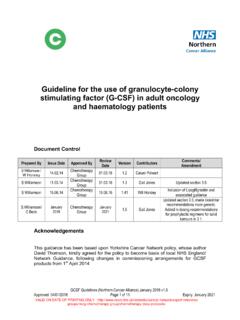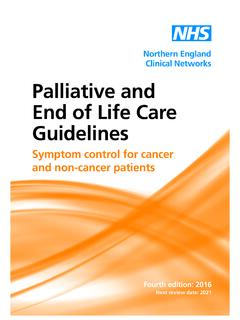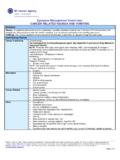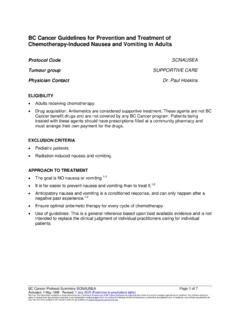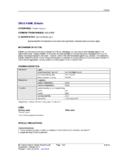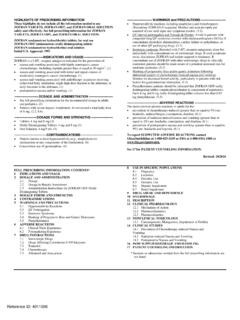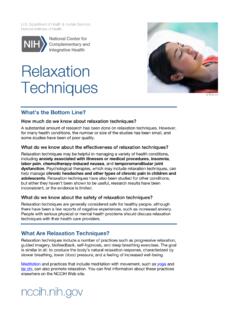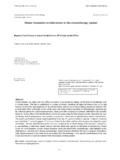Transcription of Anti-emetic Guidelines for Chemotherapy Induced Nausea …
1 Northern Cancer Alliance Anti-emetic Guidelines for Chemotherapy Induced Nausea and Vomiting (CINV) Adult Oncology & Haematology Document Control Document Title: Antiemetic Guidelines for CINV NESCN Jan 2016 Document No: NESCNCHEM 001 Current Version: Authors Steve Williamson/ Calum Polwart Approved by: Chemotherapy Group / Denise Blake Date Approved: 12/03/18 Review Date: 12/03/21 Summary of Changes Added missing cross references. Added radiotherapy increased emetogenicity & reduced emetogenicity of carboplatin. Updated guidance to reflect agreed changes to policy regarding dose of dexamethasone and NECDAG approval of aprepitant and palonosetron to match MASCC, ASCO and NCCN Guidelines . Added antiemetic ladder as an appendix.
2 Updated format, added fosaprepitant and reference to MASSC 2010 Guidelines updated table of emetogenicity Added reference to oral formulation of palonsetron Updated to reference infusion of ondansetron and revised dose schedule. Plus metoclopramide EMA recommendations. Added reference to Akynzeo (netupitant and palonosetron) as alternative to palonsetron + aprepitant, reformatted and general updates Changed summary table to localised Version of ASCO table, removed level 5 risk, Typos corrected Olanzapine added as a breakthrough option carboplatin AUC4 added to high risk (3 drug combination) as option. For more information regarding this document, please contact: Northern Cancer Alliance NHS England, Waterfront 4, Goldcrest Way, Newcastle Upon Tyne, NE15 7NY Chemotherapy Induced Nausea and Vomiting (CINV) Anti-emetic Guidelines NESCN Antiemetic Guidelines for CINV March 18 Page 2 of 16 Issue Date 12/03/18 Expiry Date 12/03/21 Summary Standard Antiemetic Cover Minimal Emetic Risk: 2-Chlorodeoxyadenosine, bevacizumab, bleomycin, busulfan, cetuximab, fludarabine, rituximab, vinblastine, vincristine, vinorelbine No antiemetic should be administered routinely before or after Chemotherapy .
3 However, normally supply metoclopramide as a rescue measure with first cycle Low Emetic Risk: fluorouracil, bortezomib, cabazitaxel, cytarabine <1000 mg/m2, docetaxel, doxorubicin HCL liposome injection, etoposide, gemcitabine, methotrexate, mitomycin, mitoxantrone, paclitaxel, panitumumab, pemetrexed, temsirolimus, topotecan, trastuzumab Agent Dose on day of Chemotherapy Dose(s) on Subsequent Days Corticosteroid Dexamethasone 8mg oral or IV No standard medication required. However, normally supply metoclopramide as a rescue measure with first cycle Moderate Emetic Risk: azacitidine, alemtuzumab, bendamustine, carboplatin <AUC4, clofarabine, cyclophosphamide<1500 mg/m2, cytarabine>1000 mg/m2, daunorubicin, doxorubicin, epirubicin, idarubicin, ifosfamide, irinotecan, oxaliplatin 5-HT3 Receptor Antagonist Ondansetron 8mg oral twice daily OR 8mg IV** Ondansetron 8mg oral Twice Daily for 2 to 3 days Metoclopramide 10mg oral Twice Daily (for patients under 60kg) OR Three Times Daily (patients over 60kg) for 3 to 5 days when required Palonosetron oral OR IV Metoclopramide 10mg oral Twice Daily (for patients under 60kg) OR Three Times Daily (patients over 60kg) for 3 to 5 days when required Corticosteroid Dexamethasone 8mg oral or IV 4mg to 8mg oral for 2 to 3 days High Emetic Risk.
4 Carboplatin AUC4*, carmustine, cisplatin, cyclophosphamide>1500 mg/m2, dacarbazine, dactinomycin, streptozocin, and combined anthracycline and cyclophosphamide regimens: All patients should be offered a three-drug combination of an NK1 receptor antagonist, a 5-HT3 receptor antagonist, and dexamethasone. The NK1 antagonist and 5-HT3 receptor antagonist may be given as a combination product Agent Dose on day of Chemotherapy Dose(s) on Subsequent Days NK1 Antagonist Aprepitant 125mg oral 80mg oral; days 2 and 3 Fosaprepitant 150mg IV Day 1 only 5-HT3 Receptor Antagonist Ondansetron 8mg oral twice daily OR 8mg IV** Ondansetron 8mg oral Twice Daily for 2 to 3 days Metoclopramide 10mg oral Twice Daily (for patients under 60kg) OR Three Times Daily (patients over 60kg) for 3 to 5 days when required Palonosetron oral OR IV Metoclopramide 10mg oral Twice Daily (for patients under 60kg) OR Three Times Daily (patients over 60kg) for 3 to 5 days when required Combined NK1 antagonist and 5-HT3 receptor antagonist Netupitant-palonosetron 300mg netupitant / palonosetron oral Metoclopramide 10mg oral Twice Daily (for patients under 60kg) OR Three Times Daily (patients over 60kg)
5 For 3 to 5 days when required Corticosteroid Dexamethasone 8 mg oral or IV (can increase to 12mg if needed) 4mg to 8mg oral for 2 to 3 days *3 drug combination for carbo >AUC4 if not adequately controlled with 2 drug regimen/ patient risk factors **Ondansetron IV must be infused over 15 minutes in patients over 65 years of age. or or or Chemotherapy Induced Nausea and Vomiting (CINV) Anti-emetic Guidelines NESCN Antiemetic Guidelines for CINV March 18 Page 3 of 16 Issue Date 12/03/18 Expiry Date 12/03/21 Contents Summary Standard Antiemetic Cover .. 2 Contents .. 3 Introduction .. 4 Drug Selection .. 4 Causes of Nausea & Vomiting .. 5 Contributing Factors .. 5 Management of Anti-emetic failure .. 7 Anti-emetic Drugs.
6 8 Metoclopramide .. 8 Dexamethasone .. 8 Ondansetron / Granisetron .. 8 Transdermal Patch versions .. 9 Alternative 5HT3 antagonists .. 9 Aprepitant .. 9 Fosaprepitant .. 9 Akynzeo (netupitant and palonosetron) .. 10 Levomepromazine (Nozinan) .. 11 Cyclizine .. 11 Nabilone .. 11 Benzodiazepines .. 11 Haloperidol .. 11 Olanzapine .. 11 Four Drug Combination with Olzanapine for high risk patients .. 11 Emetogenicity of 12 Combination Chemotherapy .. 13 Summary Standard Antiemetic Cover .. 14 Notes on Summary Sheet .. 15 Breakthrough Management: .. 15 Acknowledgments .. 16 References .. 16 Chemotherapy Induced Nausea and Vomiting (CINV) Anti-emetic Guidelines NESCN Antiemetic Guidelines for CINV March 18 Page 4 of 16 Issue Date 12/03/18 Expiry Date 12/03/21 Introduction Chemotherapy Induced Nausea and Vomiting (CINV) is one of the most frequently experienced side effects encountered by Chemotherapy patients.
7 Patients will often find the symptoms distressing, and develop anxiety about the potential for such symptoms to recur on future cycles of Chemotherapy . Modern drug treatment can successfully control CINV for the majority of patients. Scope These Guidelines are intended to support health professionals in the management and prevention of Chemotherapy Induced Nausea and vomiting. They are not intended to address radiotherapy Induced Nausea and vomiting or Nausea and vomiting in palliative care. This guidance applies to Adults only. Patient Group These Guidelines are intended to cover adult solid tumour and haemato-oncology patients receiving cytotoxic Chemotherapy within the Northern Cancer Alliance.
8 Clinical Practice These Guidelines are intended to provide a framework to support clinical practice, they cannot cover every clinical situation and good common clinical sense and clinical experience will be required when approaching the management of individual patients. Deviation from these Guidelines will be necessary in some situations and this should be appropriately documented. Drug Selection These Guidelines have purposefully chosen not to recommend one specific 5HT3 antagonist, as there is limited evidence to choose between ondansetron, granisetron and palonosetron for acute CINV. Palonosetron is more effective than other 5HT3 antagonist in preventing delayed CINV but is more expensive.
9 Dexamethasone is the backbone of many of the combinations recommended here. It should be used with caution in patients with diabetes, and should not normally be used in regimens that contain high doses of alternative steroids such as prednisolone. The dose of metoclopramide recommended here exceeds the licensed dose. Many of the individual drugs or combinations of anti-emetics described within this document are out-side of product licence. There are now three alternate choices for NK1 inhibitors, the choice of product or combination of products should be made according to local Trust factors. For all drugs the SmPC and BNF should be consulted prior to prescribing. Chemotherapy Induced Nausea and Vomiting (CINV) Anti-emetic Guidelines NESCN Antiemetic Guidelines for CINV March 18 Page 5 of 16 Issue Date 12/03/18 Expiry Date 12/03/21 Causes of Nausea & Vomiting CINV is most commonly grouped into three phases: anticipatory, acute and delayed.
10 Successful management requires correct identification of the phase (or combination of phases) being treated. Two further terminologies have been adopted in this document refractory and breakthrough. Acute Acute CINV is usually described as CINV presenting within the 24 hours immediately after administration of Chemotherapy . Delayed Delayed CINV may present any time after the first 24 hours, and may continue for up to 6 or 7 days after Chemotherapy . Anticipatory Occurs prior to administration of any Chemotherapy (in this cycle). It is either a learned response following CINV on a previous cycle or an anxiety response. It is most common after 3 to 4 cycles of Chemotherapy with very badly controlled acute or delayed symptoms.
